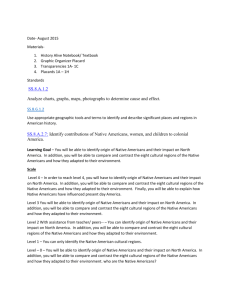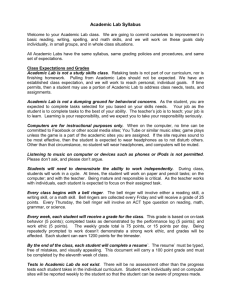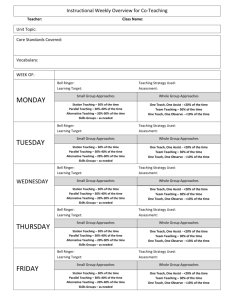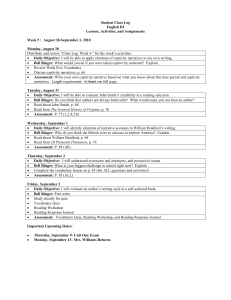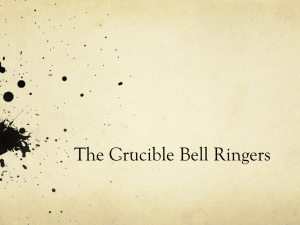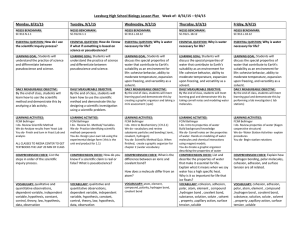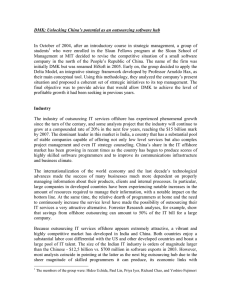Lesson Plans Aug. 24-28
advertisement
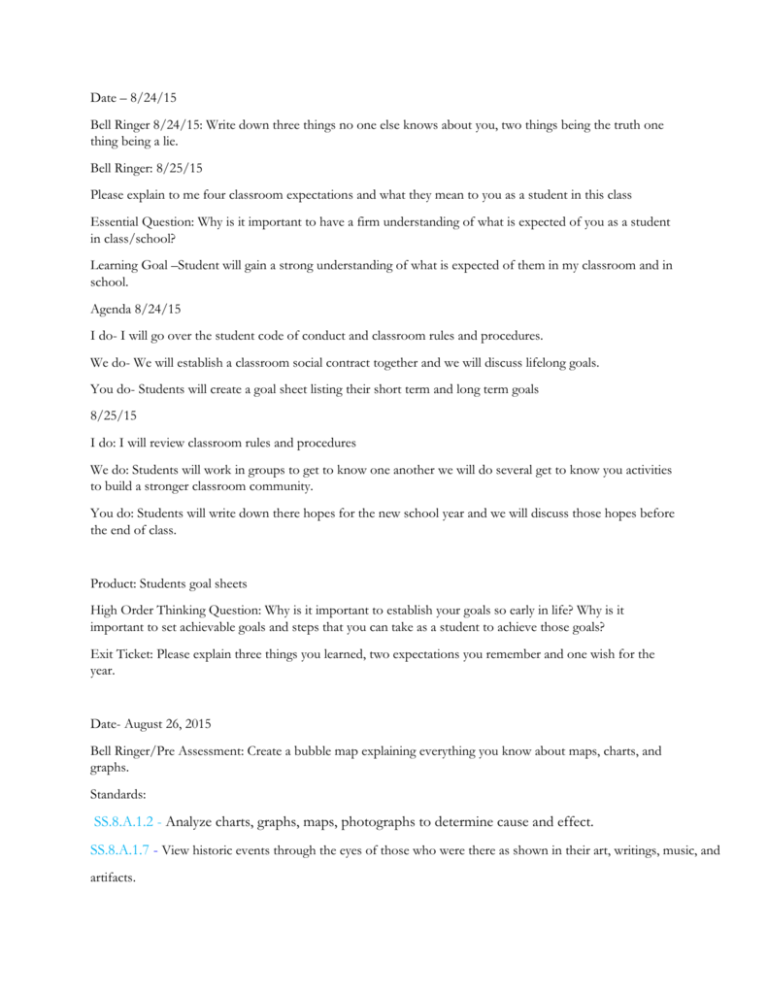
Date – 8/24/15 Bell Ringer 8/24/15: Write down three things no one else knows about you, two things being the truth one thing being a lie. Bell Ringer: 8/25/15 Please explain to me four classroom expectations and what they mean to you as a student in this class Essential Question: Why is it important to have a firm understanding of what is expected of you as a student in class/school? Learning Goal –Student will gain a strong understanding of what is expected of them in my classroom and in school. Agenda 8/24/15 I do- I will go over the student code of conduct and classroom rules and procedures. We do- We will establish a classroom social contract together and we will discuss lifelong goals. You do- Students will create a goal sheet listing their short term and long term goals 8/25/15 I do: I will review classroom rules and procedures We do: Students will work in groups to get to know one another we will do several get to know you activities to build a stronger classroom community. You do: Students will write down there hopes for the new school year and we will discuss those hopes before the end of class. Product: Students goal sheets High Order Thinking Question: Why is it important to establish your goals so early in life? Why is it important to set achievable goals and steps that you can take as a student to achieve those goals? Exit Ticket: Please explain three things you learned, two expectations you remember and one wish for the year. Date- August 26, 2015 Bell Ringer/Pre Assessment: Create a bubble map explaining everything you know about maps, charts, and graphs. Standards: SS.8.A.1.2 - Analyze charts, graphs, maps, photographs to determine cause and effect. SS.8.A.1.7 - View historic events through the eyes of those who were there as shown in their art, writings, music, and artifacts. Essential Question: What is the importance of understanding how to read a map or chart and use information from those areas to analyze given data affectively? Learning Goal –Learners will be able to read, write and create maps by the end of this lesson. Student Product: Students will complete a bubble thinking map, and students will also write Cornell notes Agenda I do- I will go over the different types of maps, charts and graphs /I will also explain marking up the text We do- We will take Cornell notes together and we will discuss the importance of being able to read graphs You do- Learners will create their own map using provide information students will draw and label how they would like. Be creative this is for a grade! High Order Thinking Question: If you were to create a map of this classroom how would you make it relevant to future students? Exit Ticket: What did you like about class today, List three things you two things you’re confident about and one thing you still need help on. Vocabulary 8/26/15 Topographical Map Global Map Weather Map Political Map Bar Graphs Road Map Charts Latitude Air Map Longitude Legend Day Two and Three 8/27/15- 8/28/15 Standard: SS.8.A.1.7 -View historic events through the eyes of those who were there as shown in their art, writings, music, and artifacts. SS.8.A.2.7 -Describe the contributions of key groups (Africans, Native Americans, women, and children) to the society and culture of colonial America. SS.8.A.1.4- Differentiate fact from opinion, utilize appropriate historical research and fiction/nonfiction support materials. Bell Ringer 8/27/15 Students will explain in detail what we did in class on 8/26/15 Bell Work 8/28/15 Student will explain the benefits of marking up the text 1 paragraph Essential Question: How did Native Americans view the environment and the land? How was their perspective different from that of the Europeans who later came to America? For each of the following regions, explain how the Native American inhabitants fed, clothed, and sheltered themselves: Northwest Coast, California, Great Basin, Plateau, Southwest, Great Plains, and Eastern Woodlands, and Southeast. Learning goal: You will be able to identify origin of Native Americans and their impact on North America. In addition, you will be able to compare and contrast the eight cultural regions of the Native Americans and how they adapted to their environment. Objective: Student will be able to analyze text related to how Native Americans lived. Student will also gain a firm understanding of how Native American impacted society I do: I will introduce the lesson by explaining marking up the text as a reading strategy. Students will be shown how to differentiate fact from opinion by marking the given text up per sentence in Native American Packet. We do: You will read, mark up the text and work together to complete questions on your own at home You Will: Work affectively in your group and have accountable talk about subject matter only Vocabulary 1. 2. 3. 4. 5. 6. 7. 8. 9. 10. 11. 12. 13. 14. 15. 16. 17. 18. 19. Abundant Strait Migrated Environment Plateau Natural resources Culture Cultural Region Indigenous Migration Mission Harvested Uprooted Adobe Pueblo Irrigation Ambush Century Edible Higher Order Question: If you were able to travel back in time what are three things you would bring with you from 2015 and what three things you would learn and bring back from early American period? Exit Ticket: What did you like about class today? List three things you learned about Native Americans Homework: None- 8/27/15 Complete Question Packet 8-/28/15 Scale Level 4 – In order to reach level 4, you will have to identify origin of Native Americans and their impact on North America. In addition, you will be able to compare and contrast the eight cultural regions of the Native Americans and how they adapted to their environment. Finally, you will be able to explain how Native Americans have influenced present day America. Level 3 You will be able to identify origin of Native Americans and their impact on North America. In addition, you will be able to compare and contrast the eight cultural regions of the Native Americans and how they adapted to their environment. Level 2 With assistance from teacher/ peers-- – You can identify origin of Native Americans and their impact on North America. In addition, you will be able to compare and contrast the eight cultural regions of the Native Americans and how they adapted to their environment. Level 1 – You can only identify the Native American cultural regions. Level – 0 – You will be able to identify origin of Native Americans and their impact on North America. In addition, you will be able to compare and contrast the eight cultural regions of the Native Americans and how they adapted to their environment. who are the Native Americans?
